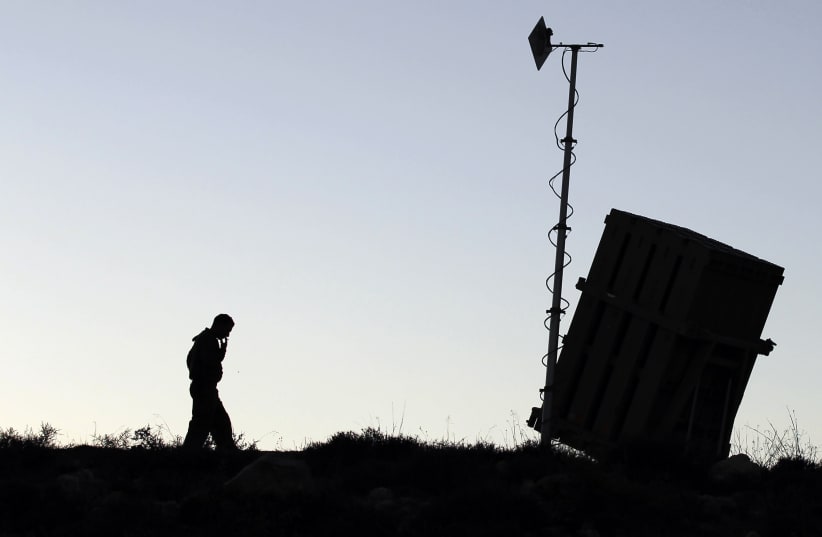But ensuring the ongoing capability of Iron Dome against Hamas can and should go well beyond purchasing additional interceptors, and the events of this month can be the catalyst to fully integrate US and Israeli missile defense.
The US Army originally planned to purchase two Iron Dome batteries in 2020, then cut the order to one because of challenges incorporating the proprietary Israeli system into existing US missile defense architecture.
But these challenges can be overcome with the establishment of the joint Raytheon-Rafael Area Protection Systems Iron Dome production facility in the United States that was announced last August. If Biden is serious about his commitment to support Iron Dome, his administration should make getting this facility operational, supported with robust contracts from the US military, a top priority.
ON A visit to an Iron Dome battery outside of Ashkelon in southern Israel in early July 2014, the IDF soldiers manning it peppered the US military in our delegation with questions about combating boredom. Their job at the time was to be on a hair-trigger alert for incoming rockets that never seemed to come. They clearly felt that being stationed in that Iron Dome battery had to be the worst assignment in the IDF.
In a matter of days, these same bored IDF soldiers would be on the front lines of one of the hottest places on the planet. During our trip, the bodies of three Israeli teenagers who had been abducted by Hamas from a bus stop in Hebron the previous month, Naftali Fraenkel, Gil-Ad Shaer, and Eyal Yifrah, were recovered, sparking a furious response from the IDF – which in turn sparked a shower of missiles into Israel from Gaza.
The Iron Dome batteries lit up the night sky over Tel Aviv, perhaps most famously in the “Iron Dome wedding” video in which the intercepted rockets seem like fireworks.
Due at least in part from calls for restraint from the Obama administration, Operation Protective Edge came to a premature conclusion in August 2014, with Hamas degraded but not conclusively defeated. Iron Dome, however, was firmly established as the gold standard for defending against short-range rockets.
This month, Iron Dome is once again in the news, this time for its virtuoso performance over the two weeks of Operation Guardian of the Walls defending against 90% of an unprecedented barrage of 4,000 rockets fired into Israel from Gaza by Hamas – an outburst designed to test whether Hamas’s burgeoning store of Iranian-supplied projectiles was finally sufficient to overwhelm the missile defense system.
It did no such thing; continual upgrades fueled by Israeli ingenuity, such as the capability to intercept mortar fire and armed drones, which it did not have in 2014, combined with strong, bipartisan support from the US Congress, enabled Iron Dome to do its job admirably, at least this time.
While it is to be hoped that the recent operation will slow Hamas down for a while, the Biden administration’s unfortunate shades-of-2014 insistence on a short-order ceasefire means that the terrorist group can once again rebuild, aided by the windfall of economic relief its Iranian sponsors anticipate from the negotiations in Vienna for the US to reenter the Obama-era nuclear deal.
And if Tehran supplies Hamas with increasing numbers of high-caliber rockets, is Israel going to be able to respond with a sufficient number of Iron Dome batteries and interceptors to protect its civilians when the terrorist group attacks again?
WHICH RETURNS us to Biden’s recent assurances to Netanyahu. Getting the Raytheon-Rafael Area Protection Systems facility up and running in short order will make them more than just words; it will be a tangible demonstration of a commitment to the security of both our peoples.
And this collaboration can have benefits far beyond the boundaries of the United States and Israel. Countries under threat from hostile missile fire from Saudi Arabia to South Korea are interested in acquiring Iron Dome systems of their own, which could be integrated into collective regional missile defense networks, especially if they are now interoperable with other American systems.
The new US facility will accelerate the production of additional batteries for potential sales, along with a ready supply of Tamir and the US variant SkyHunter interceptors to send the clear signal to friend and foe alike that the United States, Israel and our allies are fully prepared for the next barrage of terrorist rockets.
The writer is a senior fellow at the Center for Security Policy and former US deputy national security advisor for Middle Eastern and North African Affairs.
